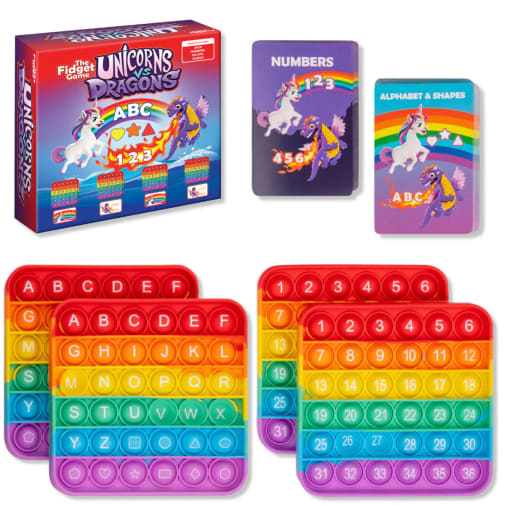If you have a child who loves fidget toys, adores unicorns, and is currently learning their letters, this set is just perfect! A wonderful blend of sensory stimulation, fun, and educational activity, this game engages children by appealing to some of their favorite things—in this case, fidget toys and magical creatures. The game comes with fouyr double-sided fidget toys and two decks of cards, a number deck and a letter deck. One side of the fidget shows numbers on each bubble, while the other shows letters and shapes. To play, draw a card and then pop the corresponding numbers or letters on your fidget! The first player to pop all their bubbles wins—but watch out for the dragon cards, which show you certain bubbles to un-pop! Includes 72 letter & shape cards, 72 number cards, and 4 double-sided fidgets. Instruction guide included.
Unicorns vs Dragons Game
SKU
033263
Grade PK-K
These icons are designed to help you quickly understand and learn important information about our products.
Teaching Method
Traditional
Teacher-centered curriculum commonly used in classrooms that may include a text, teacher manual, tests, etc.
Charlotte Mason
A methodology based on the work of a 19th century educator who maintained that children learn best from literature (Living Books), not textbooks.
Classical
A methodology based on the Latin Trivium (three stages of learning), including the grammar stage (memorization and facts), logic stage (critical thinking), and rhetoric stage (developing/defending ideas).
Unit Study
A thematic or topical approach centered around one topic that integrates multiple subject areas.
Montessori (Discovery)
A methodology based on the work of a 20th century educator that emphasizes student and sensory-driven discovery learning and real-life applications.
Other
Other methodologies
Religious Content
Secular
Contains content contrary to common Christian beliefs (i.e. evolution).
Neutral
Avoids religious or theoretical topics or presents multiple viewpoints without preference.
Christian/Religious
Faith-based or including instructional religious content.
Learning Modality
Auditory
Learns through listening, talking out loud or reading out loud.
Visual
Learns through seeing, prefers written instructions and visual materials.
Kinesthetic/Tactile (Hands-On)
Learns through moving, doing and touching.
Multi-Sensory
Curriculum that employ a variety of activities/components.
Presentation
Sequential
Curriculum progresses through well-defined learning objectives. Emphasizes mastery before moving to the next topic.
Spiral
Topics and concepts are repeated from level to level, adding more depth at each pass and connecting with review.
Conceptual/Topical
Focus is on the “why,” often with a unifying concept as well as specific skills; coverage may be broader.
Teacher Involvement
Low Teacher Involvement
Student-led materials; parent acts as a facilitator.
Medium Teacher Involvement
A mix of teacher-led time and independent student work.
High Teacher Involvement
Teacher-led lessons; may utilize discussions, hands-on activities and working together.
Additional Materials Required
No other materials needed
Everything you need is included.
Other Materials Required
There are additional required resources that are a separate purchase.
Other Materials Optional
There are additional resources mentioned or recommended but are not absolutely necessary.
Consumable
Consumable
Designed to be written in; not reusable.
Non-Consumable
Not designed to be written in; reusable.
Our Price
$34.99 $34.99 $29.99
Rainbow Savings: $5.00
Product Overview
- Educational and magical game combines fidget toys, magical creatures, and letter and number recognition!
- Each card you draw shows you what bubbles to pop on your fidget, which has numbers on one side and letters and shapes on the other
- Be the first player to pop all your bubbles, but watch out for dragon cards, which tell you to un-pop bubbles!
- Includes 4 double-sided fidget cards, a number card deck, and a letters and shapes card deck
Description
Publisher's Description of Unicorns vs Dragons Game
How To Play:
- Choose your deck - ABCs & Shapes or Numbers
- Choose a card
- Unicorn Card = Pop Bubbles
- Dragon Card = Unpop Bubbles
- Pop all of your bubbles to win!
- 4 Double-Sided Fidget Letter Mats
- 72 ABC & Shapes Cards
- 72 Numbers & Counting Cards
- 1 Instruction Guide
- Identify all letters of the alphabet!
- Master all letter sounds!
- Identify all the colors of the rainbow!
- Master colors and shapes!
- Can count to 36!
- Learn matching skills!
Details
| Product Format: | Other |
|---|---|
| Grades: | PK-K |
| Brand: | The Fidget Game |
| EAN/UPC: | X003T94SLR |
| Length in Inches: | 6.25 |
| Width in Inches: | 6.25 |
| Height in Inches: | 3.8125 |
| Weight in Pounds: | 1.55 |
Videos
Reviews

